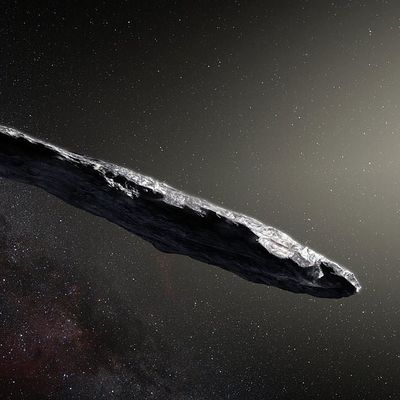
In October of last year, a mysterious, cigar-shaped interstellar object fell through our solar system at an extraordinary speed. When the Pan-STARRS 1 telescope in Hawaii first discovered “Oumuamua” — the object’s official nickname, meaning “a messenger who reaches out from the distant past” in Hawaiian — researchers assumed that it was an ordinary comet or asteroid. But the longer they observed Oumuamua, the more improbable that hypothesis appeared: After all, what kind of asteroid is ten times longer than it is wide, and suddenly accelerates in speed, for no discernible astrophysical reason?
A new paper from scientists at the Harvard-Smithsonian Center for Astrophysics offers an answer: the kind of asteroid that is actually a solar-powered component of an alien spacecraft that broke off its mothership while investigating Earth’s solar system.
Specifically, the paper postulates that Oumuamua is a “solar sail” — an object that propels itself through space by channeling solar energy, which is a technology that intelligent life-forms (such as they are) on Earth have already developed. This hypothesis would explain why Oumuamua suddenly accelerated while traveling through our solar system.
“Considering an artificial origin, one possibility is that ‘Oumuamua is a light sail, floating in interstellar space as a debris from an advanced technological equipment,” the study notes. “This would account for the various anomalies of ‘Oumuamua, such as the unusual geometry inferred from its light-curve, its low thermal emission, suggesting high reflectivity, and its deviation from a Keplerian orbit without any sign of a cometary tail or spin-up torques.”
But not everyone is convinced. As CNN reports:
“I am distinctly unconvinced and honestly think the study is rather flawed,” Alan Jackson, fellow at the Centre for Planetary Sciences at the University of Toronto Scarborough, wrote in an email. “Carl Sagan once said, ‘extraordinary claims require extraordinary evidence’ and this paper is distinctly lacking in evidence nevermind extraordinary evidence.”
Jackson published a paper in the Monthly Notices of the Royal Astronomical Society in March that suggests that ‘Oumuamua came from a binary star system, or a system with two stars.
Jackson said the spectral data from ‘Oumuamua looks like an asteroid or a comet, while that of a solar sail would look very different. The new paper proposes that the sail has been coated in interstellar dust, which obscures its true spectral signature.
“Any functional spacecraft would almost certainly retract its solar sail once in interstellar space to prevent damage,” Jackson said.
“The sail is useless once away from a star so there would be no reason to leave it deployed. If it was then deployed again on entering the solar system it would be pristine. Even if it was left deployed the dust accumulation would be primarily on the leading side like bugs on a windshield.”
Either way, Oumuamua is the first object human beings have ever seen in our solar system that is known to have originated outside of it. And while the “no, it is not an alien solar sail” theory looks compelling on paper, Oumuamua’s ostensible behavior — briefly observing the Earth in October 2017, and then promptly fleeing our solar system at 196,000 miles per hour — is undoubtedly what any remotely intelligent life form would do.






























